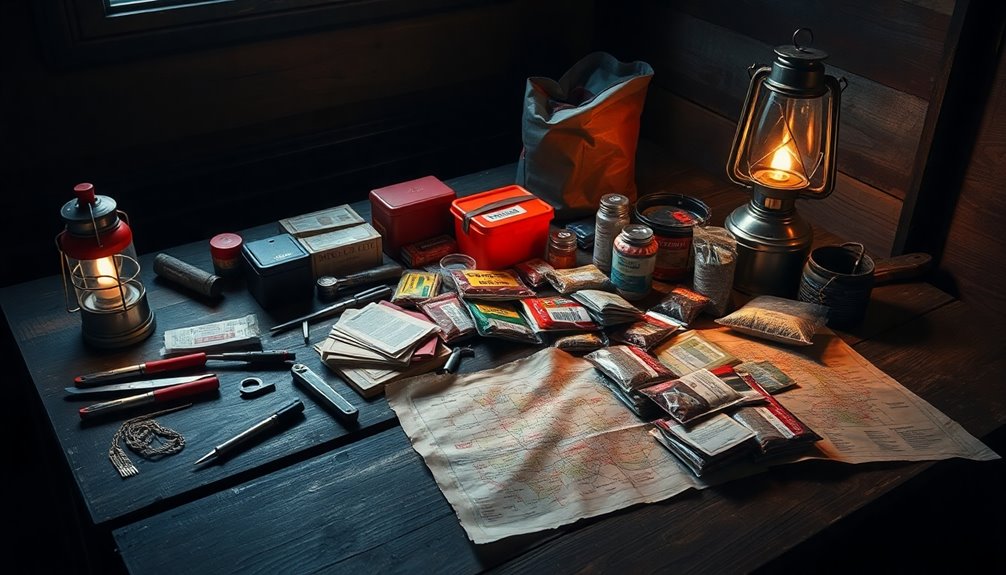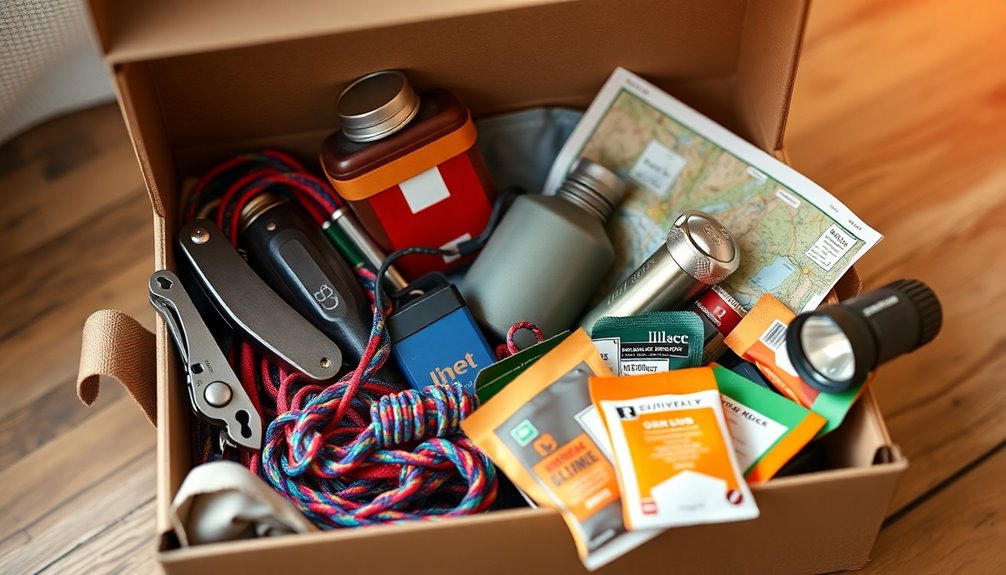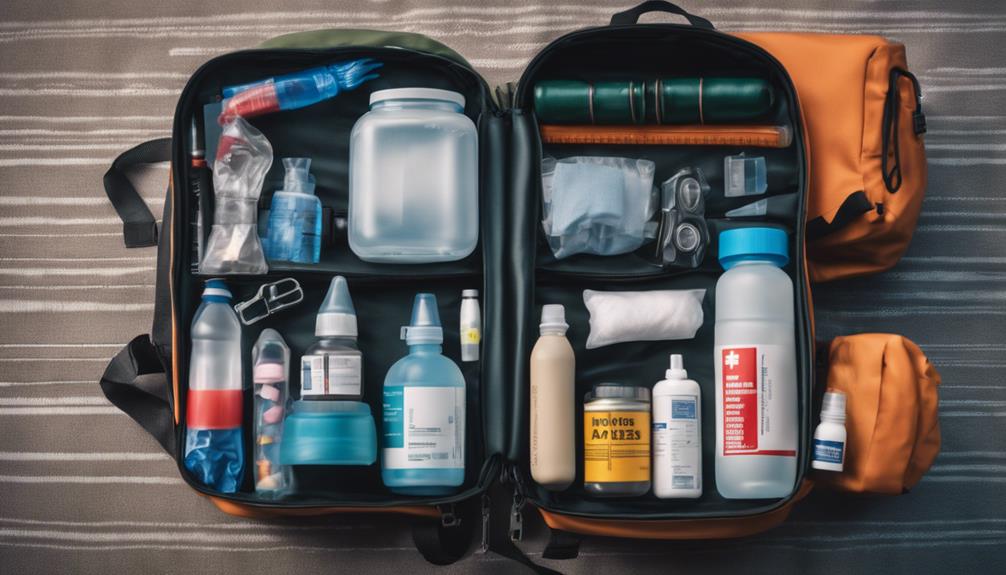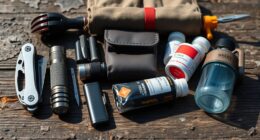Are you ready for the ultimate survival test? A doomsday prep list can help you gear up for any challenge! Start with at least 1 gallon of water per person daily for three days, plus yummy canned foods and grains for energy. Don't forget medical supplies like band-aids and hand sanitizer! You'll also want to know how to create cozy shelters and stay warm using natural materials. For power, think solar panels or generators, and keep handy tools like a compass! With a dash of practice in survival skills, you'll be all set. There's so much more to explore, so let's get prepared!
Key Takeaways
- Ensure a minimum water supply of 1 gallon per person per day for at least 3 days; rotate and purify as needed.
- Stock essential medical supplies, including bandages, antiseptics, and hygiene products like antibacterial soap and hand sanitizer.
- Build a sturdy shelter using natural materials, prioritizing insulation and protection from the elements.
- Equip yourself with power sources like solar panels and generators, and maintain communication tools like satellite phones.
- Develop survival skills, including shelter building, navigation, and first-aid, to enhance your preparedness in emergencies.
Essential Water Supplies
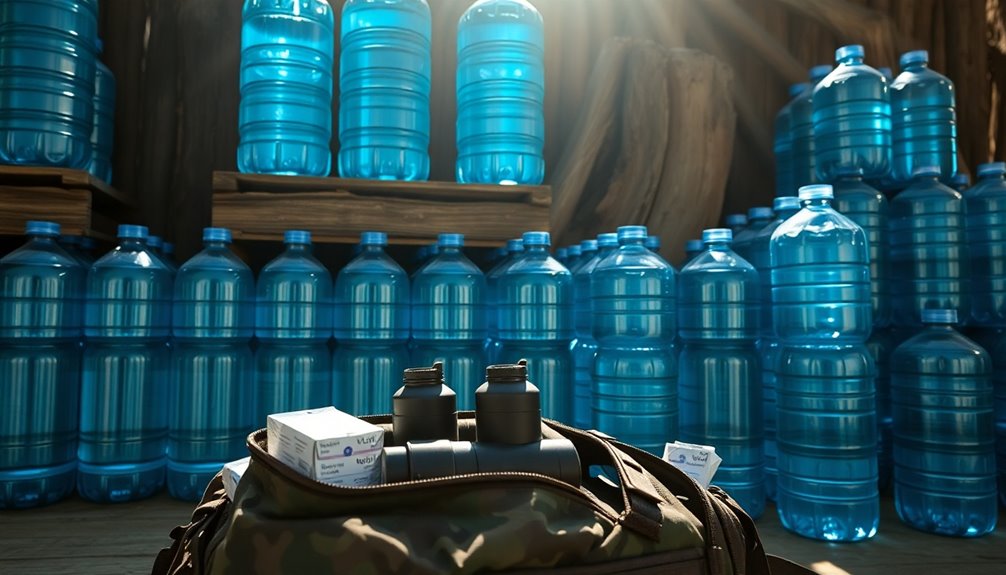
When preparing for emergencies, it's crucial to ensure you have enough water supplies on hand. You should aim for at least one gallon of water per person and pet, each day, for a minimum of three days.
Imagine you have a family of four—storing 28 gallons means everyone stays happy and hydrated! Remember to think about how active you're and the weather, too. If it's hot outside, you might need more.
Don't forget to rotate your water regularly, especially if it's stored in warm places, like your car trunk. You might find commercially bottled water to be a safe and handy choice. Additionally, it's important to use a balanced supply of water sources, including home-filled containers, to ensure you have multiple options during emergencies.
Plus, if you're feeling adventurous, you can collect rainwater or even dew from plants. Just remember, if you get water from springs or under the ground, make sure it's safe to drink!
Lastly, when it comes to purifying your water, boiling it for five minutes is your best bet to kill germs. You can also try water purification tablets or filters to make sure your water stays clean.
Food Storage and Preparation
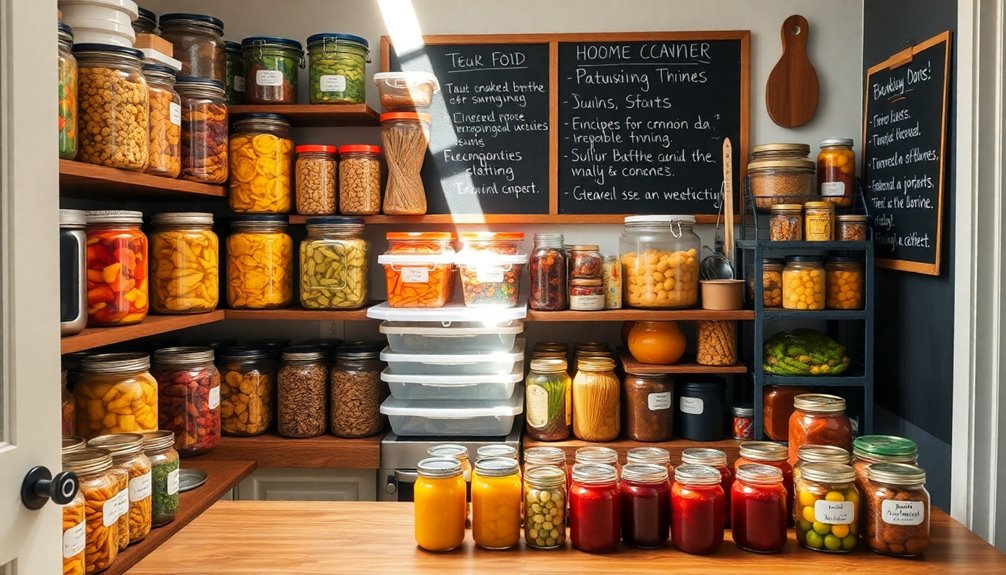
How can you ensure your food supply lasts during an emergency? First, think about a balanced diet! You want to store foods that keep you healthy and full of energy. Canned or dried fruits and vegetables can liven up your meals and add some nutrition to your diet.
Don't forget about meats—canned tuna or freeze-dried chicken are great options that last a long time!
For grains, pasta, and rice are your best friends. They can last anywhere from 10 to 20 years if stored right. Use airtight containers like Mylar bags or food-grade buckets to keep out pesky pests and moisture. Adding oxygen absorbers can help your food stay fresh even longer. Additionally, maintaining proper storage conditions like a consistent temperature can further extend the shelf life of your supplies.
Now, let's chat about shelf life! Some foods, like powdered milk, should be eaten within six months, while others can last forever when stored properly. It's super important to check your supplies regularly for any spoilage.
And hey, don't forget to label everything! You'll thank yourself later when you can quickly find what you need. So gear up, plan wisely, and get ready for anything!
Medical Supplies and Hygiene
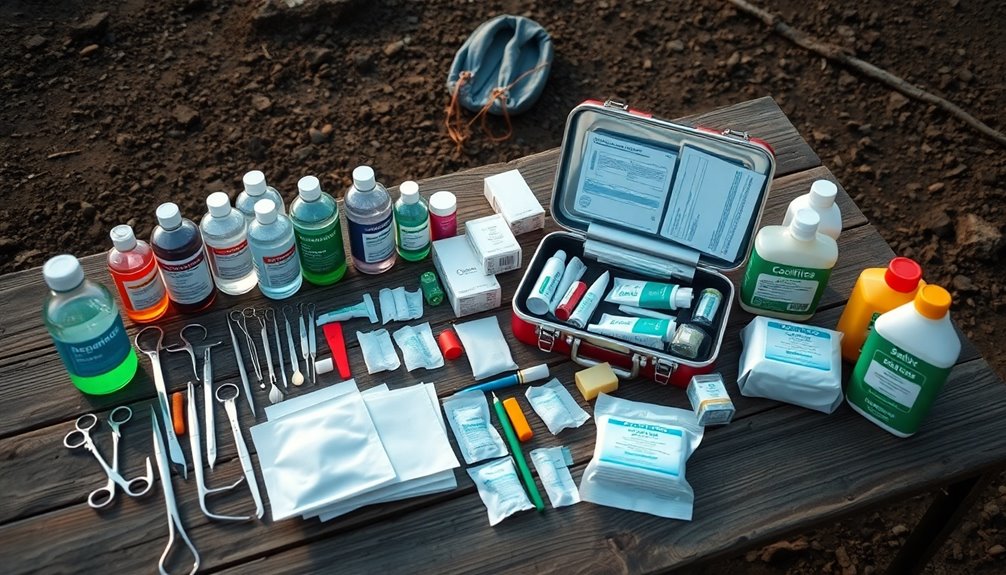
Your medical supplies and hygiene essentials are crucial for survival in an emergency. Imagine a time when you might need to treat a scrape or stay clean without running water!
First, gather bandages and dressings in various sizes, like ace bandages and gauze pads, to help cover cuts and bruises. Don't forget antibiotic ointment and antiseptic wipes to keep wounds clean and prevent infection. Including a Recon Medical tourniquet can also be vital for controlling severe bleeding.
You'll also want a few handy tools, like scissors and tweezers. These can be lifesavers when you need to remove splinters or cut bandages. For checking health, a thermometer and blood pressure cuff can help you monitor how you feel.
Now, let's talk hygiene! Stock up on antibacterial soap, hand sanitizer, and wet wipes to keep yourself fresh and clean.
Safety gear, like nitrile gloves and masks, can also protect you while dealing with injuries.
Lastly, remember some fun items like large trash bags for waste disposal! Staying organized and clean will help you feel better, even in tough situations.
Building Shelter and Staying Warm

Building a shelter is essential for protecting yourself from the elements and staying warm in an emergency. First, choose a good spot, away from rocks and muddy areas, where you can find plenty of building materials.
If you're in the wilderness, consider using fallen trees as a base for a lean-to or building a cozy debris hut. Make sure to use natural insulation like leaves or dead grass on the roof, aiming for at least one to four feet thick. This helps keep the warmth in! Additionally, ensure that you assess ground level to guarantee stability and safety for your shelter.
If you're thinking of something more permanent, like an underground bomb shelter, use sturdy concrete for walls and a dome-shaped roof to protect against harsh conditions.
Don't forget to dig deep enough, and make sure your shelter can handle wind and rain by adding proper support and air vents.
For extra warmth, create a comfy bed inside using insulating materials like spruce needles or grass.
Power Solutions and Communication
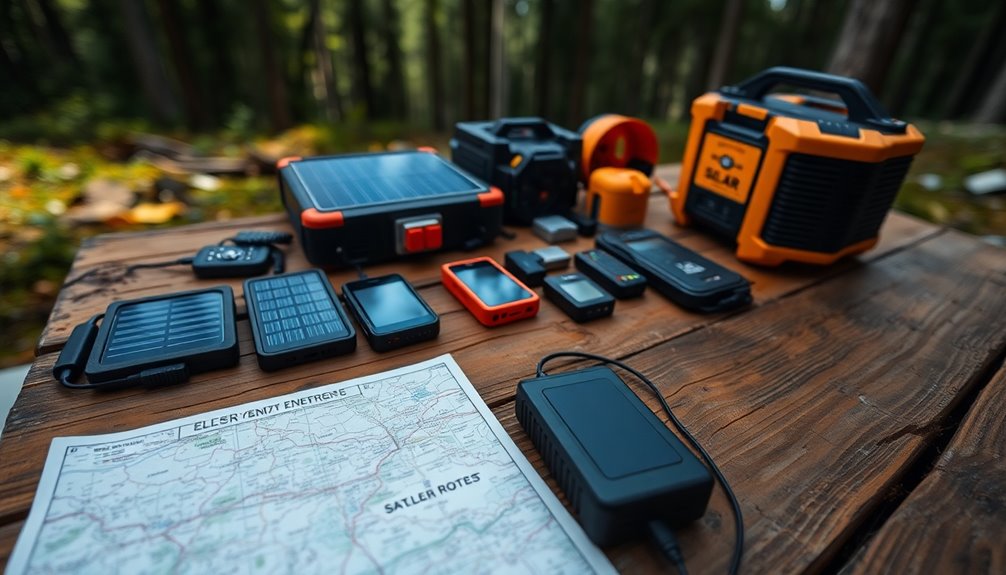
When it comes to surviving in a doomsday scenario, having reliable power solutions and communication methods is crucial. Imagine waking up to a world without electricity!
You'll want to harness the sun with solar panels, which turn sunlight into electricity. They're low maintenance and last a long time, but make sure you've got storage for that energy. Additionally, understanding power generation options is essential for effective emergency planning. Consider incorporating rainwater capture techniques to help supplement your energy needs while reducing reliance on municipal systems. A good portable water container can also help ensure you have enough water to complement your power solutions. Energy-efficient technologies can further enhance your power generation systems to maximize their effectiveness. Furthermore, utilizing geothermal heat pumps can provide a sustainable and efficient heating and cooling solution for your shelter. According to recent advancements, the latest models of solar panels for 2024 offer improved technology that can significantly increase energy efficiency.
If you live where the wind blows, wind turbines can help, but they need careful planning and might make a bit of noise!
Generators are another option. They run on fuel like gasoline or propane, giving you power when you really need it. Just remember to keep them outside to avoid nasty fumes.
For communication, a satellite phone is a must-have. It helps you stay connected when regular phones don't work, but don't forget extra batteries!
You can also use portable power sources, like a hand-crank generator or small solar chargers, to keep your gadgets running.
With these tools in your survival kit, you'll be ready to tackle anything that comes your way, while staying lit and connected!
Keep prepping, and you'll be a doomsday pro in no time!
Self-Defense Measures
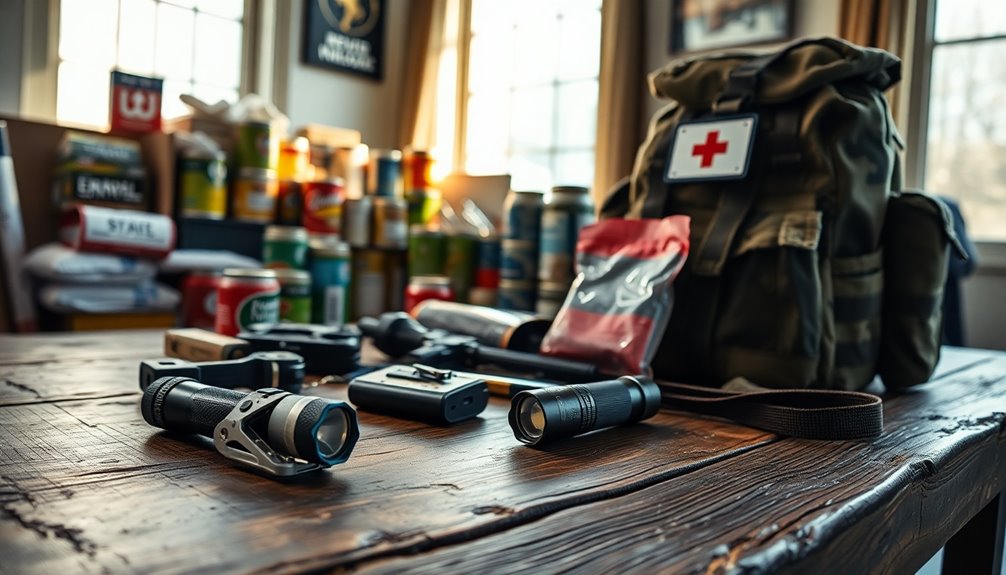
Self-defense measures are essential in a doomsday scenario, where threats can arise unexpectedly. First, always keep your eyes peeled for potential dangers. If a situation feels off, trust your gut and leave! Maintaining a safe distance from any possible threat gives you more time to react.
Remember, assess whether someone has the means, intent, and opportunity to cause harm, and steer clear of high-crime areas.
If you find yourself facing a threat, increase the distance between you and the danger. If that's not possible, use nearby objects as barricades. Always look for escape routes before you engage in physical defense. When you must defend yourself, position yourself against a wall to keep an eye on entrances.
Practicing physical self-defense techniques can be a game-changer! Stand with your weight evenly distributed, and keep your hands up. Learn how to break free from grabs and protect your airway if needed. Additionally, being aware of your surroundings and maintaining situational awareness can significantly enhance your ability to respond effectively to threats.
The most important part is to stay calm, even when facing wildlife or a scary situation. With practice and awareness, you'll be ready for anything. So gear up, stay alert, and let's get prepared for whatever comes our way!
Tools for Survival Tasks
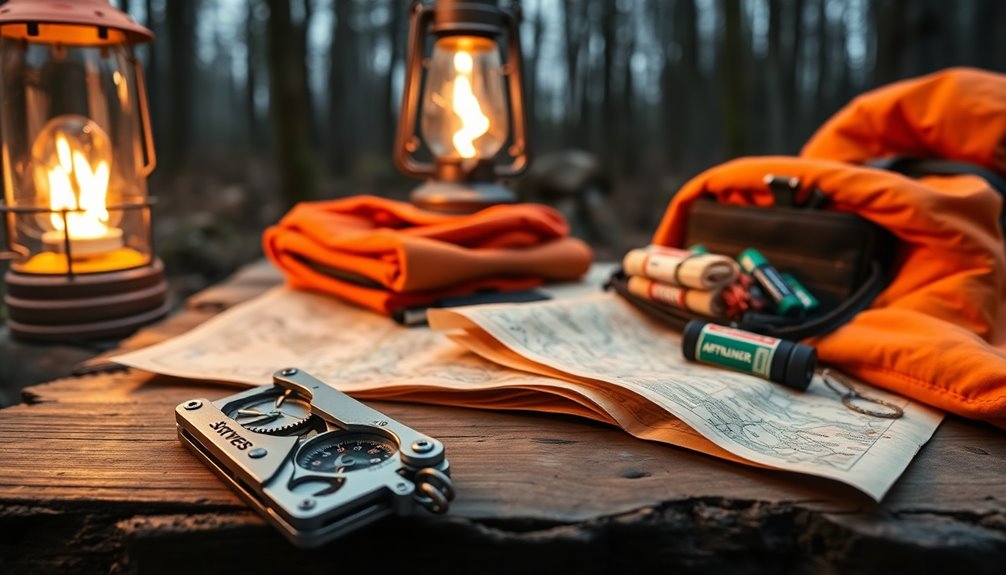
Surviving a doomsday scenario requires more than just self-defense; being equipped with the right tools can make all the difference.
Imagine you're lost in the wilderness without a clue! That's where a compass, maps, and a GPS device come to the rescue, guiding you safely back to civilization. Plus, a signal mirror and whistle can help you catch the attention of rescuers—just don't forget to practice your best "Help!" face!
When it comes to shelter, a Mylar blanket can keep you warm, while a tarp provides a cozy roof over your head. Understanding wilderness survival skills will enhance your ability to build effective shelters and navigate your surroundings.
Don't forget the 550 Paracord, perfect for building your makeshift haven. Staying hydrated is vital, so grab a metal water bottle and some purification tablets. They'll turn even the sketchiest water into a refreshing drink!
If you're hungry, a trusty knife, lighter, or waterproof matches will start a fire for cooking. A camp axe can chop wood, and a portable camping stove can whip up a meal that would make your mom proud.
With these tools in hand, you're ready to tackle any survival challenge that comes your way!
Frequently Asked Questions
How Do I Choose the Right Location for My Survival Supplies?
To choose the right location for your survival supplies, think about accessibility first!
You'll want a spot that's easy to reach, even in the dark. A cool, dry basement is great, but make sure it's safe from leaks or cracks.
Organize your items in bins, labeling them for quick access. Keep perishables in a dark, cool place and don't forget to rotate your supplies regularly—freshness is key to being prepared!
What Skills Are Essential for Survival Beyond Physical Supplies?
To survive, you need skills beyond just supplies!
First, practice problem-solving by tackling puzzles or games. This helps you think quickly when things get tricky.
Next, build emotional resilience by staying calm and finding meaning in tough times.
Don't forget to develop a support network of friends you can rely on.
Finally, learn new skills, like first aid or navigation, so you're ready for anything.
How Can I Involve My Family in Preparedness Planning?
Get your family excited about preparedness planning! Start by holding a fun family meeting where everyone can share their thoughts on what disasters might happen.
Assign cool roles, like "Safety Captain" or "Supply Guru," so everyone feels involved. Create a disaster supply kit together, and practice your plan every few months.
Remember to include your pets in the discussion! When you work as a team, you'll feel ready for anything that comes your way!
What Are the Best Practices for Rotating Emergency Food Supplies?
To keep your emergency food supplies fresh and tasty, you'll want to follow a few fun steps!
First, use the first-in, first-out method, which means you grab the oldest food first. Keep track of what you have by making a list, and check those expiration dates regularly!
Rotate items like dried fruits every six months, and remember to stash away some comfort foods.
You'll be ready for anything, and your meals will still be delicious!
How Do I Stay Informed About Potential Disasters in My Area?
To stay informed about potential disasters in your area, you can sign up for Wireless Emergency Alerts (WEAs) on your phone, which are like special text messages from local officials.
Don't forget to tune into NOAA Weather Radio for continuous updates!
Also, keep an eye on local news and social media for the latest info.
Conclusion
Now that you’ve got your doomsday prep list, you’re ready to take on any challenge! Remember, it’s all about being smart, safe, and a little bit silly sometimes—like practicing your survival skills with friends. Gather your water, food, and tools, and make sure you’ve got a cozy shelter to stay warm. With a sprinkle of creativity and a dash of fun, you’ll be well-prepared for the ultimate survival test. Let’s get prepping and adventure on! Don’t forget to also consider the importance of first aid supplies and communication devices to stay connected with others. It’s also crucial to stay informed and educated about potential risks and how to respond to them. Whether it’s a power outage or a natural disaster, your survival skills and preparation can also come in handy in times of societal collapse. Stay vigilant and always be prepared for the unexpected. Survival preparation for societal collapse is not just about physical supplies, but also mental and emotional resilience.

